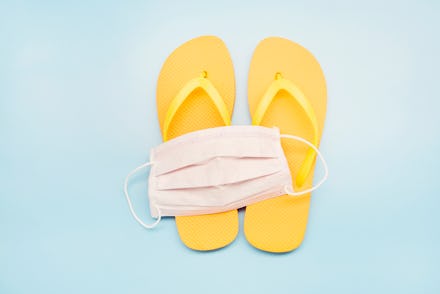Why we shouldn't count on summer to stop coronavirus

At a press briefing on April 23, President Trump surmised that warmer weather could slow the spread of the novel coronavirus, echoing a possibility he’d raised earlier. “There’s a theory that, in April, when it gets warm — historically, that has been able to kill the virus,” he’d said back in February. Now, that's a big and dangerous claim to make and we all know that Trump has hit us with some zingers of coronavirus cure claims in the past. But could summer curb transmission of COVID-19?
As it turns out, Trump’s ramblings may actually contain a kernel of truth. Emerging evidence suggests that warm temperatures, humidity, and more sunlight could lower the novel coronavirus’s rate of infection. But as many outlets point out, using them to predict how the pandemic will unfold in the real world is tricky. Even if the summer does help slow transmission, it probably won’t do so drastically, or stop it entirely — meaning we can’t relax just yet.
Weather conditions may explain some of the geographic differences in transmission of the novel coronavirus. For instance, although the Miami metro area’s population demographics and density are comparable to those of the Bronx, Queens, and Brooklyn, Miami-Dade County had around 14,000 cases and 500 deaths, while New York had close to 179,000 cases and more than 14,700 deaths, ABC News reported on May 11.
These patterns are consistent with research summarized in April by the National Academies of Sciences, Engineering, and Medicine, which looked at studies that both tested the impacts of heat, humidity, and UV light on the virus in the lab, and examined these effects in the real world, per Vox.
Even if the summer does help slow transmission, it probably won’t do so drastically, or stop it entirely — meaning we can’t relax just yet.
The National Academies’ review of the lab studies found that, for the most part, increased heat, humidity, and UV light appear to impair the virus, according to Vox. These included a study that William Bryan, undersecretary for science and technology in the Department of Homeland Security, described at the April 23 White House briefing. It showed that greater sun exposure, humidity, and heat reduced the virus’s survivability in respiratory droplets and on the surfaces where they settled.
How summer conditions could affect the novel coronavirus remains a bit murky. In theory, humidity could trap virus-laden respiratory droplets from infected people, so that they land on the ground rather than on passersby, and heat may help disrupt the virus’ outer lipid coating, Vox says. And UV light, found in sunlight, is already used to kill germs.
But as the National Academies itself noted, the lab studies in its summary have significant limitations — a big one being that they haven’t undergone peer review, the formal vetting process used to ensure a study meets rigorous scientific standards.
Plus, the novel coronavirus may behave differently in the real world, where conditions aren’t nearly as controlled as they are in the lab, Vox points out. Shifts in temperature, humidity and sun exposure might affect immunity, WIRED explains, with humid air moistening the outer mucus layer that protects cells from potential invaders. We also tend to stay indoors in the winter, crowding alongside others and breathing poorly ventilated air, which can facilitate the virus’ spread.
Human behavior and other social factors may also be more important in transmission than weather conditions. In New Orleans, for instance, the Mardi Gras celebration in late February is thought to have been a major contributor to the virus’ spread, despite temperatures rising to the 70s and 80s, according to Vox. Among all states, Louisiana had the fifth-most deaths per 100,000 people as of April 29.
The studies incorporating real-world data that the National Academies reviewed as part of its summary are also preliminary. One such study, forthcoming from the University of Nebraska Medical Center, modeled the impacts of humidity, heat, and UV light. While the researchers showed that these variables lessened viral transmission, they told Vox that they still needed to replicate and verify their results.
The National Academies concluded that, while there’s some evidence to suggest warm weather can curb the spread of the novel coronavirus, “given the lack of host immunity globally, this reduction in transmission efficiency may not lead to a significant reduction in disease spread without the concomitant adoption of major public health interventions,” wrote Harvey Fineberg, author of the report, per Vox. In other words, since we’re still so vulnerable to infection with the novel coronavirus, the weather alone might not be enough to stop its mass spread.
As much as we’d love to imagine the novel coronavirus vanishing under the summer sun, now is not the time to chill and ignore it.
A study of COVID-19 cases in 144 countries, published in the Canadian Medical Association Journal on May 8, aligns with this conclusion, reporting that humidity had little association with slowed transmission, while temperature had no effect on it, the New York Times reports. Meanwhile, social distancing and other public health measures were significantly associated with differences in transmission.
Indeed, viruses that our immune systems haven’t seen before don’t appear to be seasonal, WIRED explains. When the 2009 H1N1 flu strain emerged in humans at the tail end of the regular flu season, it spread throughout the summer, fall, and winter, until it became a seasonal strain the following year.
And if COVID-19 becomes endemic, or constantly present in the population, like the cold or flu, it, too, may follow a seasonal pattern — but that might not happen for years, experts agree. As much as we’d love to imagine the novel coronavirus vanishing under the summer sun, now is not the time to chill and ignore it.